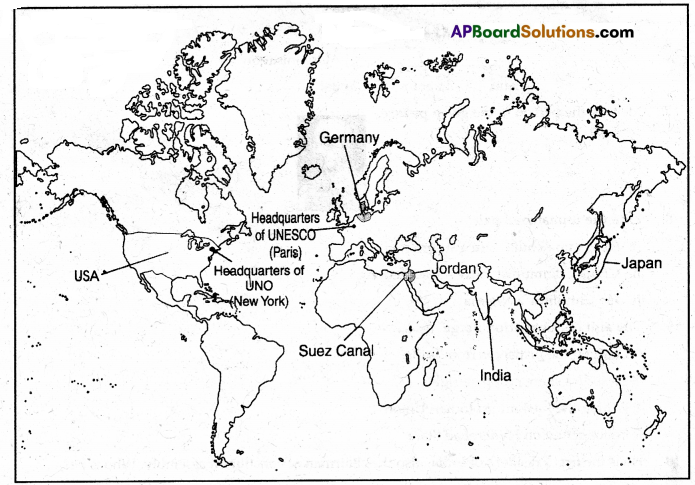Access to a diverse set of AP 10th Class Social Model Papers Set 1 ensures a well-rounded preparation strategy.
AP 10th Class Social Model Paper Set 1 with Solutions
Time: 3.15 hours
Max. Marks: 100
Instructions:
- In the duration of 3 hours, 15 minutes, 75 minutes of time is allotted to read the question paper.
- All answers shall be written in the separate booklet only.
- Question paper consists of 4 Sections and 33 Questions.
- Internal choice is available in Section IV only.
- Answers shall be written neatly and legibly.
Section – I
12 × 1 = 12 M
Note:
1) Answer all the questions.
2) Each question carries 1 mark.
Question 1.
In the graph of the distribution of households in India, the bottom part shows …………………. .
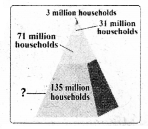
Answer:
Deprived income group
Question 2.
What is the state that has highest literacy rate and low IMR?
Answer:
Himachal Pradesh
Question 3.
For which purpose IPCC organisation was formed?
1. To reduce the emissions of greenhouse gases
2. To reduce the usage of plastic
3. To reduce the conflicts among the countries
Answer:
To reduce the emissions of greenhouse gases.
Question 4.
The place shown in the map is ……………….. .

Answer:
Uttar Pradesh
Question 5.
What is the time difference between IST and GMT’?
Answer:
Indian Standard Time is 5½ hours ahead of Greenwich mean time.
Question 6.
Based on the relationship between the information in the first pair, complete the second pair.
Buffaloes: Physical capital
Feed from the land:?
Answer:
Working capital
![]()
Question 7.
Identify the wrongly matched one.
A) Dubagunta Rosamxna – Anti Arrac Movement
B) Irom Sharmila – AFSPA
C) Medha Patkar – Silent Valley Movement
Answer:
Medha Patkar Silent Valley Movement (Medha Patkar – Narmada Bachao Andolan)
Question 8.
Find the correct statement.
A) The president of Indian Union is generally bound by the advice of ministers.
B) Prime Minister is the first citizen of the country.
1) A only
2) B only
3) A & B are correct
4) A & B are wrong
Answer:
1) A only
Question 9.
The term ‘horrors of war’ is found in the preamble of ………………….. .
Answer:
Japan
Question 10.
Identify the person in the picture.

Answer:
N.T. Rama Rao
Question 11.
The policy followed by the British in India ……………… .
Answer:
Divide and Rule policy
Question 12.
Fill the box.
The tribal languages not taken into account during the formation of linguistic states:
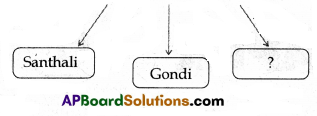
Answer:
Oraon
Section – II
8 × 2 = 16 M
Note:
1) Answer all the questions.
2) Each question carries 2 marks.
Question 13.
Define percapita income.
Answer:
Per capita, income is the rate of the total income of the country divided by its total population.
Per capita income = \(\frac{\text { Total income of the country }}{\text { Total population }} \)
Question 14.
Expand W.T.O.? What is the main aim of W.T.O.?
Observe the map and answer the following questions 15 and 16.
Answer:
- W.T.O. means World Trade Organisation.
- The aim of WTO is to liberalise International Trade.
Question 15.
Why do winds always blow towards low-pressure regions?
Answer:
Winds always blow towards low-pressure regions because
- In low-pressure regions temperature is high and evaporation is more
- Warm air rises, so cool air replaces it.
![]()
Question 16.
When do the southwest monsoons blow in India?
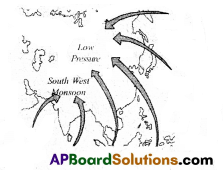
Answer:
The southwest monsoons blow in India at the beginning of June and July from Kerala.
Question 17.
What is Cold War?
Answer:
The war which is fought behind closed doors through propaganda and words without any physical attack or direct war is known as Cold War.
Question 18.
Why did the black Americans begin the Civil Rights Movement in 1960s?
Answer:
- Segregation of the Blacks and Whites (in schools, buses, and public places)
- Discrimination in appointments, housing, and in voting rights.
Question 19.
Give a few suggestions to strengthen communal harmony.
Answer:
Suggestions to strengthen communal harmony.
- Promoting secular ideas among people.
- Celebration of festivals together.
- Cultural programmes to promote communal harmony.
- Conducting universal prayers.
![]()
Question 20.
In which year was RTI Act formulated and expanded RTI.
Answer:
RTI Act was formulated in 2005. RTI stands for Right to Information.
Section – III
8 × 4 = 32 M
Note:
1) Answer all the questions.
2) Each question carries 4 marks.
Question 21.
Prepare two slogans on ‘Control of population growth’.
Answer:
- More population – More problems.
- Control the population – Control the pollution.
- Small family – Happy family.
- Population explosion leads to starvation.
Question 22.
Draw the bar graph on the basis of information given in the table below.
Employment in three sectors
| Sectors | Employment (%) | |
| Agriculture | 1972-73 | 2011-12 |
| 74 | 53 | |
| Industrial | 11 | 22 |
| Service | 15 | 25 |
Answer:
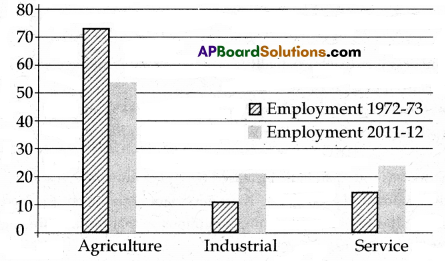
Question 23.
Analyse how the public Distribution system provides access to food to the poor.
Answer:
- National Food Security Act legalizes people’s right to food. It is applicable to 2/3rd of the population of India.
- PDS ensures availability of food grains to the poor at subsidised rates.
- Antyodaya cardholders are entitled to get 35 kgs of food grains (rice or wheat) per month per family.
- Every person of low-income families is entitled to 5 kilograms of food grains per month at subsidised rates.
- 75% of people living in rural areas purchases food grains through PDS. 50% of the urban population purchase food grains through PDS.
- PDS helps in maintaining nutrition status of the people.
Question 24.
Why do we often use the term “Indian peninsula”?
Answer:
1. Peninsula is a region, which is surrounded by water on three sides.
2. India is often referred as “Indian peninsula” because it is surrounded by water boundaries on three sides. They are:
- East – Bay of Bengal
- West – Arabian Sea
- South – Indian Ocean
Question 25.
Observe the following map of Cold War Military Alliances and answer the questions.
i) Among United Kingdom, Portugal, France, and the Soviet Union, which is an island country?
ii) Of Poland, Belgium, Hungary and Spain, which are in Eastern Europe?
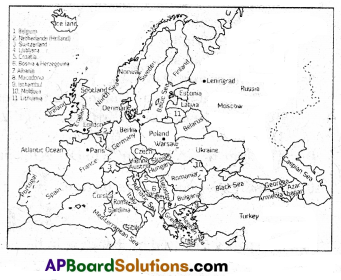
Answer:
i) United Kingdom
ii) Poland and Hungary.
Question 26.
Write briefly about the present relations between India and Pakistan.
Answer:
- Indo-Pakistan relations over last seven decades are largely, marked by mutual suspicion, animosity, and hostilities.
- The fact that India was partitioned into Bharat and Pakistan in the communal holocaust left a lasting influence on the relations between the two countries.
- The differences regarding Kashmir issue have been still continuing.
- Infiltrations, attacking the border villages, encouraging terrorism by Pakistan worsened the relations.
![]()
Question 27.
What were the four main demands of Bhopal gas victims?
Answer:
The main demands of Bhopal gas victims
- Proper medical treatment of the victims
- Adequate compensation based on international standards
- Fixing criminal responsibility for the disaster on the management of the multinational company
- Steps to prevent disasters in future.
Question 28.
What are the steps taken by the present Indian Government to check the corruption and black money?
Answer:
1. It banned ₹ 500 and ₹ 1000 notes to control black money.
2. Severe raids are conducted on government officials who are taking black money.
3. Severe punishments are given and penalties are charged to control black money.
4. Strict vigilance is maintained on deposits and withdrawals of money from the banks.
Section-IV
5 x 8 = 40 M
Note:
1) Answer all the questions.
2) Each question carries 8 marks.
3) Each question has internal choice.
4) In question no.33, both A and B (India map and World map) should be answered separately.
Question 29.
A) Observe the given pie chart and write a paragraph analysing it.
Social background of short-term migrants in India, 2007-08.
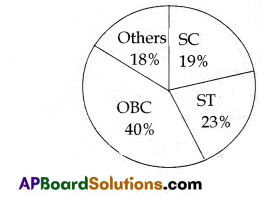
(OR)
B) Observe the given table and answer the question that follows.
Crop Production (Kilograms per Hectare)
| Crop | 1950-1951 | 2000-2001 |
| Paddy | 668 | 1901 |
| Wheat | 655 | 2708 |
| Pulses | 441 | 544 |
| Oil seeds | 481 | 810 |
| Cotton | 88 | 190 |
| Jute | 1043 | 2026 |
Q. Write an analysis on the yielding trends of different crops.
Answer:
A)
- The given pie diagram indicates social background of short-term migrants in India in 2007-2008.
- The period of short-term migrants is often less than six months. Most of the seasonal migrants are from tribal communities and poor families.
- In India, short-term migrants from other backward classes are occupying first place with 40%. Scheduled tribes are occupying second place with 23% and Scheduled castes are occupying third place with 19%.
- However, this number is increasing gradually. The government is taking certain steps to check migration in their native places. It is one good step
B)
- The table indicates the crop production differences between 1950-51 and 2000-2001 in India.
- The food grains such as paddy increased three times, wheat four times, and oil seeds two times in 50 years.
- But the cash crops such as cotton and jute increased two times only in 50 years.
- Producing a sufficient amount of food grains is an important requirement for food security. In India, the government has to create supporting conditions so that farmers are able to produce increasing amounts of food grains.
![]()
Question 30.
A) ‘India is blessed with many river systems. Without them, the country will become a describe In this context explain the uses of the rivers to us.
(OR)
B) Indian agriculture depends completely on the monsoon.’ Describe the cycle of the monsoon patterns.
Answer:
A)
- Rivers act as lifelines to the country.
- Rivers form very fertile soils called alluvial soils by bringing fine silt along their course.
- Buy building many dams and projects across the rivers, the agricultural lands are having irrigation facilities.
- Water from the rivers is supplied for the running of many industries.
- Hydroelectricity is generated through the rivers.
- They also act as the medium of transportation through inland waterways.
- Many people depend on the rivers for their livelihood through fishing.
- Mainly rivers arc giving life to the people by supplying drinking water and also for domestic purposes.
B)
- Indian climate mostly depends upon monsoons.
- Most of the rainfall occurs in monsoonal season. ,
- In ancient period, due to the lifestyle of the people which was natural and non-pollutive, formation of seasons was in time and there is sufficient rainfall.
- So, there were no disturbances in agriculture.
- But, due to the increase in technology and industries, the atmosphere has been polluted and global warming is taking place.
- Due to this untimely inadequate rainfall, untimely seasons, cyclones, depressions, floods, droughts etc are happening.
- In this situation, cultivation became a difficult task for the farmers.
- From the days of ploughing and sowing seeds, due to the insufficient rainfall, the crops have dried up.
- Though the crops are good, due to the unexpected rains at the time of harvesting results in a great loss.
- Likewise, Indian agriculture became a gamble with unpredictable with the monsoons.
Question 31.
A) Read the given para and comment on it. The Taliban, which took over Afghanistan after the withdrawal of Soviet troops, similarly established an extremist Islamic state. These states tried to force all the people to strictly follow the rules Laid down in religious texts. In many cases, this meant the denial of basic freedom and equality of opportunity to women and religious minorities.
(OR)
B) Read the following paragraph and write your opinion Racism became common in the British colonial empire in late 19th” and early 20th centuries. Educated Africans were excluded from the civil service, and there was discrimination against African entrepreneurs. At the same time, the authorities from the ruling country gave control to the tribal chiefs and elite and promoted them.
Answer:
A)
- The religious extremism is always a threat to world. Any religion preaches love, brotherhood, kindness towards fellow human beings.
- Simply forcing people to strict religious orthodox rules forbidding from basic freedom to live, particularly preventing women from their basic freedom is to be condemned.
- It is known fact that religious extremes have no true faith on God and religion.
- They, in the veil of religion, just try to establish their violence.
B)
- The paragraph has been taken from “National Liberation Movements in the Colonies.” In this, we understand how Nigerians showed unity against the British colonial rule which showed injustice to colonies.
- The idea of nation-states was new to the countries of Africa like the rest of the world. The people in Africa were united together through their tribal identity. The country we know as Nigeria today was actually created by the British.
- South Nigeria got access to modern education and administrative modernisation but pre-modern traditions continued in the north. Because of this, many differences came up between that two regions. The North was not able to develop modern educated social class.
- In 1939 the British encouraged competition and conflict between the three major tribal groups. The British followed the policy of ‘divide and rule’ in the country. At the same time, the authorities from ruling country, gave control to the tribal chiefs and elite and promoted them.
- A section of Western-educated intellectuals responded to this policy. They developed the idea of a common Nigerian nation and began to fight the British rule.
Question 32.
A) What are the examples and explanations you can identify with the basic features of Indian Constitution?
(OR)
B) Look at the map of India and Bangladesh and see why cooperation between the two countries is of vital importance to both.
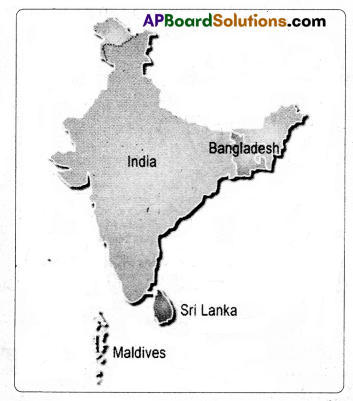
Answer:
A) The following are the basic features of the Indian Constitution:
- Democratic government
- Federal character
- Supremacy of the Constitution
- Sovereignty of the Nation
- Provisions for Justice and a Welfare state.
The following examples can be identified with the basic features of the Indian Constitution.
- Democratic government: We have adopted a democratic, parliamentary form of the government.
- Federal character: In our country there is the existence of a central polity and subsidiary polities side by side. Each is sovereign in the field assigned to it.
- Supremacy of the Constitution: We have adopted some unitary characteristics like ‘Supremacy of the central polity’.
- Sovereignty of the Nation: India is free to conduct her internal as well as external affairs as she likes. She is free to decide her internal as well as external polity.
- Provisions for Justice and a Welfare state:
(a) The High Courts and the Supreme Court form the single integrated judiciary.
(b) They have jurisdiction and provide remedies in all cases arising under the constitutional law, civil or criminal law.
(c) This is done to eliminate all diversity in all remedial procedures.
(d) Regarding welfare, the depressed classes and poorer sections of the society are provided with a range of welfare programmes like reservations, housing schemes, health schemes, employment schemes, etc.
B)
- Bangladesh shares maximum land frontier with India. It helps in increasing trade and commerce, and contacts between people.
- Bangladesh acts as connecting link to South East Asia from India.
- It acts as first wall of defense from terrorist attacks in northeastern region.
- India and Bangladesh share many common rivers, Brahmaputra, and Ganga. These can be used to develop hydropower projects.
- Bangladesh is important for India to maintain stability in north-east region.
![]()
Question 33.
Locate the following in the given map of India.
A)
a)
1) East Coastal Plain
2) Capital city of Maharashtra
3) Ooty
4) Assam
(OR)
b)
1) River Brahmaputra
2) Chandigarh
3) West Coastal Plain
4) Tamil Nadu
Answer:
a)
1) East Coastal Plain
2) Muinbai
3) Ooty
4) Assam
(OR)
b)
1) River Brahmaputra
2) Chandigarh
3) West Coastal Plain
4) Tamil Nadu
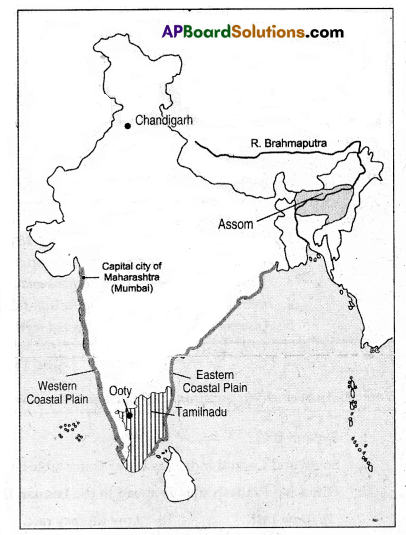
B)
a) Locate the following in the given map of world.
1) Germany
2) Jordan
3) Headquarters of UNO
4) Suez Canal
(OR)
b)
1) India
2) USA
3) Headquarters of UNESCO
4) Japan
Answer:
a)
1) Germany
2) Jordan
3) New York
4) Suez Canal
(OR)
b)
1) India
2) USA
3) Paris
4) Japan
